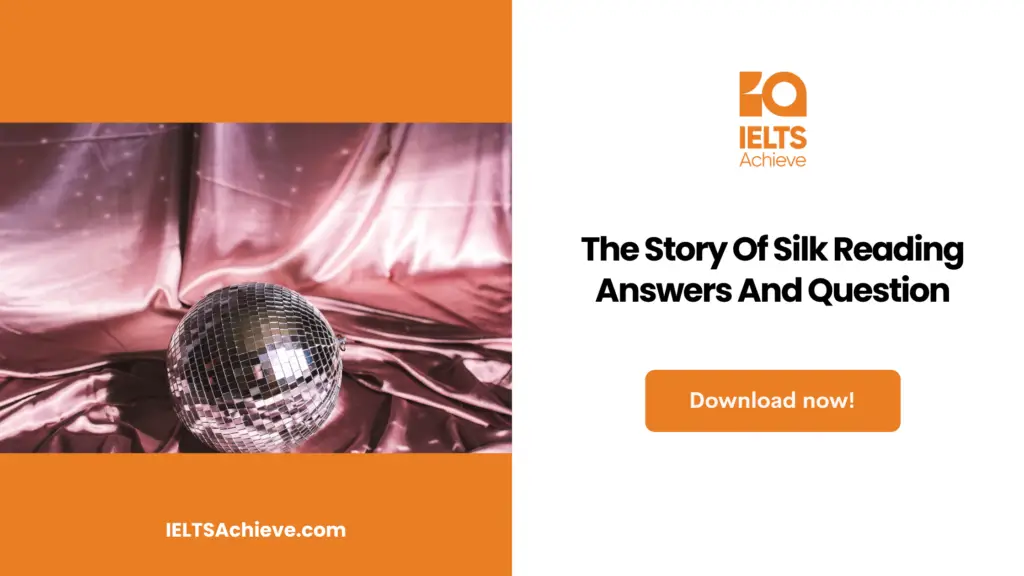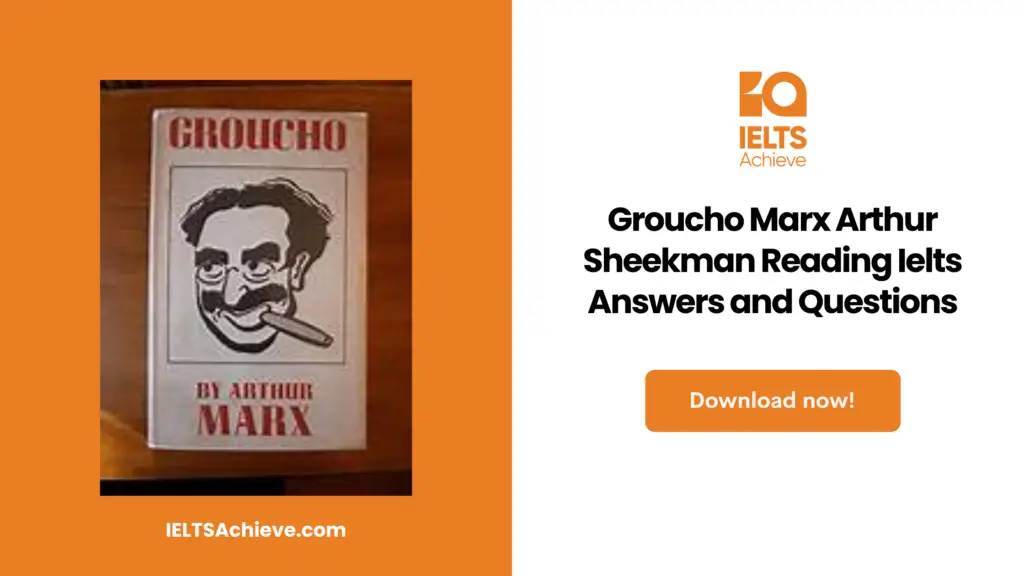The Blog post contains the following IELTS Reading Questions:
- IELTS Reading Table Completion
- IELTS Reading Note Completion
- IELTS Reading Multiple Choice Questions
Stay informed and prepared for success – Explore our comprehensive Reading Test Info page to get valuable insights, exam format details, and expert tips for mastering the IELTS Reading section.
IELTS Reading Passage – The Story Of Silk

The Story Of Silk
Mulberry silkworms make cocoons, where from the fine and smooth material is extracted, which is Silk. About 3000 BC, Lei Tzu, wife of the Yellow Emperor ruler, discovered silkworms. The story goes like this, while she was taking a walk in her husband’s gardens, she found that silkworms were destroying the several mulberry trees. She picked a number of cocoons and sat down to take a rest. It just so happened that one of the cocoons that she had collected slipped in the hot tea which she was sipping and it started to unravel into a fine thread. Lie Tzu discovered that she can wind the thread around her fingers. Consequently, she made her husband allow her to rear silkworms on a mulberry trees’ grove. She also made a special reel, by which she can draw the fibres from the cocoon, which could be strong enough to be woven into a fabric. It is still uncertain how much of this story is true, but it is a well known fact that silk cultivation existed in China for several thousand years.It was the women who were originally restricted to silkworm farming and responsible for the growing, harvesting and weaving. As royal people had the privilege to wear clothes made of silk, silk quickly became a status symbol. During the Qing Dynasty (1644—1911 AD), the rules were gradually changed that peasants can also wear silk clothes. Sometime, silk was even used as a currency unit during the Han Dynasty (206 BC-220 AD).
Silk was used in the following ways, like, government officials paid salary in the form of silk and farmers used silk and grains to pay their taxes. The Emperor used silk as a diplomatic gift. Using the silk, fishing lines, bowstrings, musical instruments and paper were all made. It was discovered that the earliest indication of silk paper was found in the tomb of a noble who is estimated to have died around 168 AD.The Silk Road was created as a trade route as the demand for the exotic fabric was increased, which takes silk westward and brings gold, silver and wool to the East. It was named the Silk Road because its precious commodity is valued more than gold. The Silk Road spans about 6000 kilometres from the Eastern China to the Mediterranean Sea, along with the Great Wall of China, Pamir mountain range, modern day Afghanistan and going on to the Middle East and Damascus which is considered as a major trading market.
The merchandise was shipped across the Mediterranean sea from there. Some merchants travelled across the entire route and mostly, the middlemen handled the goods. China was the only producer of silk for hundreds of years in the world, as the mulberry silkworm was native to China. Through the Byzantine Empire, which ruled about the Mediterranean region of southern Europe, North Africa and the Middle East during the period 330—1453 AD, the secret of making silk spreaded rest of the world. One of the legends stated that in 550 AD, monks who were working for Justinian, the Byzantine emperor, smuggled the silkworm eggs by concealing it with hollow bamboo walking canes to Constantinople. The Byzantine is similar to the Chinese in terms of being secretive, anyway, the weaving and trading of silk fabric was in the state of strict imperial monopoly for many centuries. After, in the 7th century, Arabs captured the magnificent skills of Persia, when they had conquered them. Arabs sail through the lands of Africa, Sicily and Spain where the silk production had spread.
In the tenth century, Andalusia in southern Spain was considered Europe’s major silk producing centre. Italy became Europe’s leader in silk production and export by the thirteenth century. Venetian merchants traded silk in an extensive manner and motivated silk growers to settle in Italy. Currently also, the reputation of silk processing in the province of Como in northern Italy has been maintained.The European silk industry was ruined during the nineteenth century and industrialisation. When the Suez Canal was opened, it cleared the way for cheaper Japanese silk trade, which is one of the many factors driving the trend. And, the new manmade fibres, like nylon, started to be used in the substitution of silk products such as stockings and parachutes. The European silk industry was stifled by the two world wars which disturbed the raw materials supply. Japan produced the silk with improved production and the quality of raw silk, after the second world war. The privilege of being the world’s biggest producer in the world has remained for Japan and till the 1970s, Japan was the only main exporter of raw silk. China slowly reattained the position of world’s biggest producer and exporter of raw silk and silk yarn. As of now, 125,000 metric tons of silk are produced in the world. And, China produces about two thirds of the production.
Unlock your full potential in the IELTS Reading section – Visit our IELTS Reading Practice Question Answer page now!
Recommended Questions:
Renewable Energy IELTS Reading Question with Answer
The Story Of Silk IELTS Reading Questions
After you have done the following questions. Check the story of silk reading answers with explanation.
Questions 1 – 5
Choose the correct letter, a, b, c or d.
1. Who discovered the silkworms
a. Yellow Emperor
b. Yellow Emperor’s sister
c. Lao Tzu
d. Lei Tzu
2. Who were originally responsible for growing, harvesting and weaving the silk ?
a. Childrens
b. Women
c. Men
d. Old people
3. In which dynasty did silk used as a unit of currency ?
a. Han Dynasty
b. Xia Dynasty
c. Qing Dynasty
d. Shang Dynasty
4. Who spreaded the silk making secrets to the rest of the world ?
a. Han Empire
b. Ottoman Empire
c. Byzantine Empire
d. Qing Empire
5. Which was considered as Europe’s major silk producing centre in southern Spain ?
a. Aragon
b. Canary Islands
c. Murciad. Andalusia
Ready to improve your performance in Multiple Choice Questions (MCQs)? Click here to access our comprehensive guide on how to tackle MCQs effectively in the IELTS Reading section.
Questions 6 – 9
Complete the notes below.
Write NO MORE THAN TWO WORDS AND/ OR A NUMBER from the passage for each answer.
- 6_____ is the sole producer of silk for hundreds of years
- Monks who were working for 7______ Emperor Justinian smuggled silkworms by concealing it from the 8_____ walking canes to Constantinople.
- Byzantine is secretive like Chinese.
- Arabs conquered 9______, where they have captured magnificent skills, after the 10_______.
Boost your performance in Summary, Notes, Table, and Flowchart Completion tasks. Click here to explore our detailed guide and learn how to effectively complete summaries, notes, tables, and flowcharts in the IELTS Reading section.
Questions 11 – 13
Complete the table below.
Choose NO MORE THAN TWO WORDS AND/OR A NUMBER from the passage for each answer.
| Years | Instances/ Events |
| 168 AD | The earliest indication of 11____ was found in the tomb of a noble who had died |
| 12 ______ | Monks smuggled the silkworm eggs by concealing it with hollow bamboo walking canes to Constantinople |
| Till the 1970s | 13______ was the major exporter of raw silk |
Boost your performance in Summary, Notes, Table, and Flowchart Completion tasks. Click here to explore our detailed guide and learn how to effectively complete summaries, notes, tables, and flowcharts in the IELTS Reading section.
Unlock your full potential in the IELTS Reading section – Visit our IELTS Reading Practice Question Answer page now!
Recommended Questions:
Renewable Energy IELTS Reading Question with Answer
The Story Of Silk IELTS Reading Answers
1. d. Lei Tzu
2. b. Women
3. a. Han Dynasty
4. c. Byzantine Empire
5. d. Andalusia
6. China
7. Justinian
8. Bamboo
9. Persia
10. 7th Century
11. Silk paper
12. 550 AD
13. Japan

We hope you found this post useful in helping you to study for the IELTS Test. If you have any questions please let us know in the comments below or on the Facebook page.
The best way to keep up to date with posts like this is to like us on Facebook, then follow us on Instagram and Pinterest. If you need help preparing for the IELTS Test, join the IELTS Achieve Academy and see how we can assist you to achieve your desired band score. We offer an essay correction service, mock exams and online courses.

